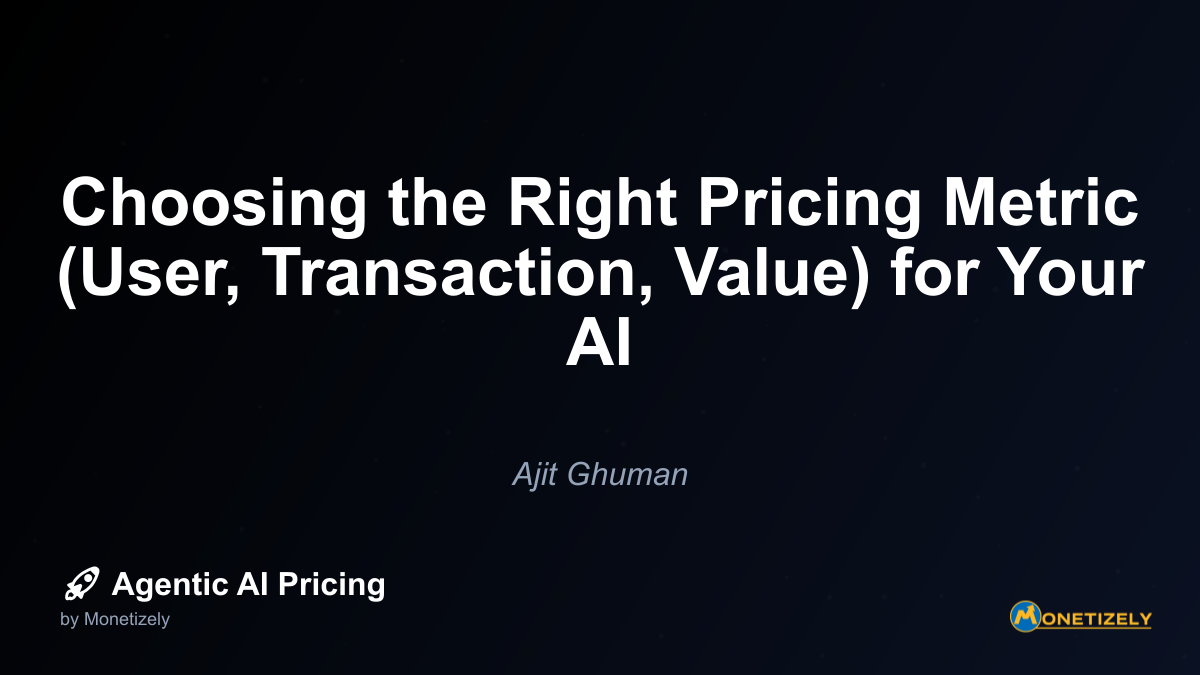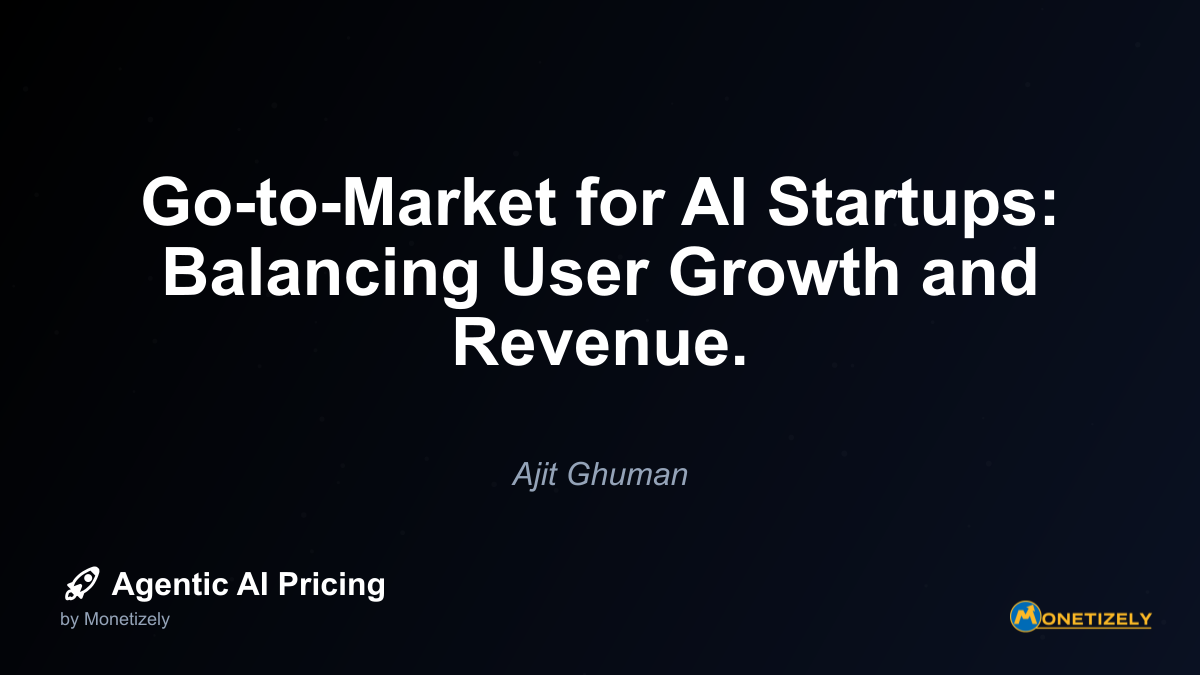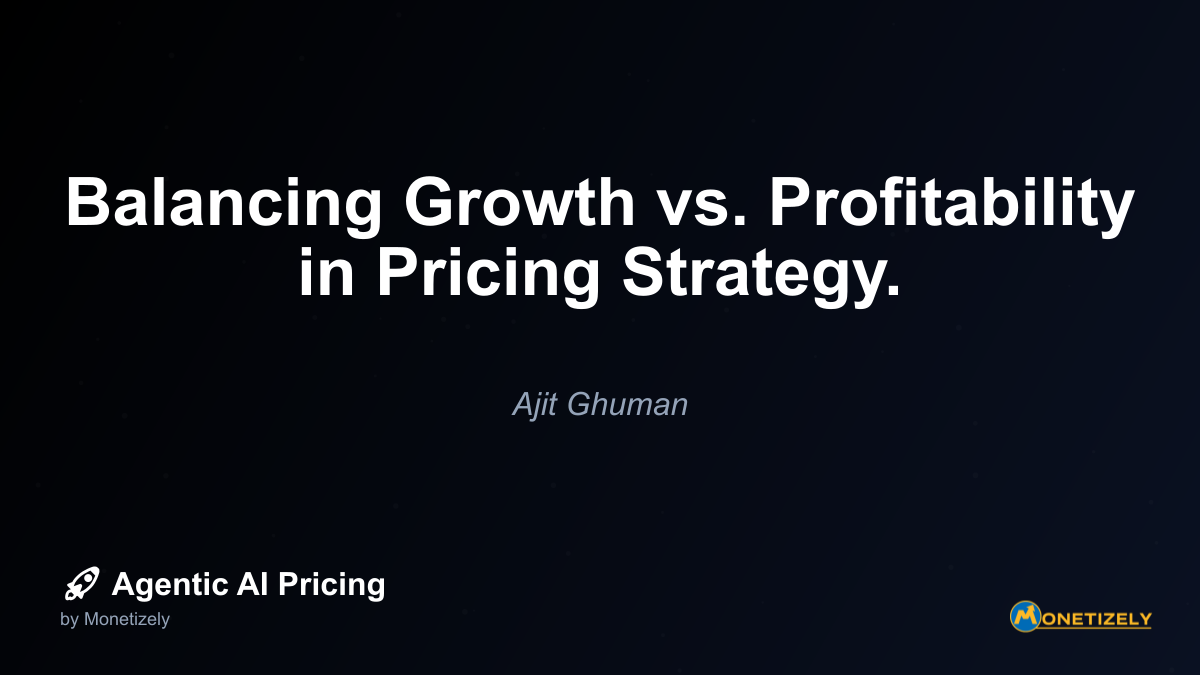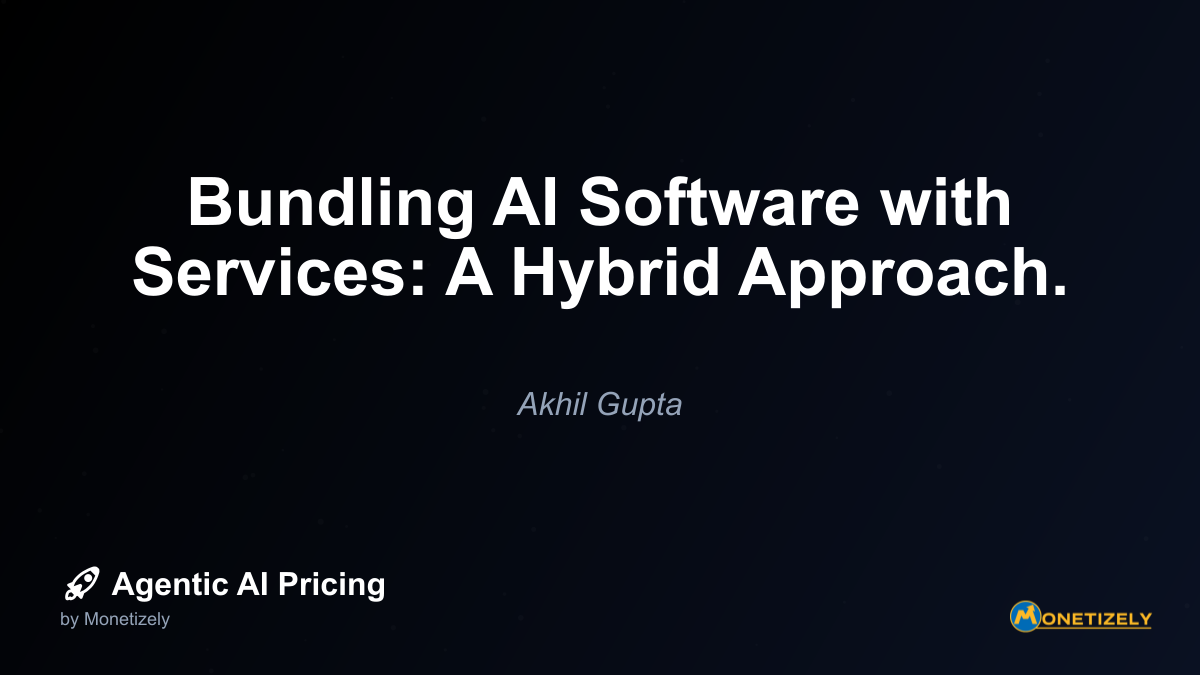· Akhil Gupta · Strategy & Planning · 7 min read
Using AI to Optimize Your Own Pricing Strategy.
AI and SaaS Pricing Masterclass
Learn the art of strategic pricing directly from industry experts. Our comprehensive course provides frameworks and methodologies for optimizing your pricing strategy in the evolving AI landscape. Earn a professional certification that can be imported directly to your LinkedIn profile.
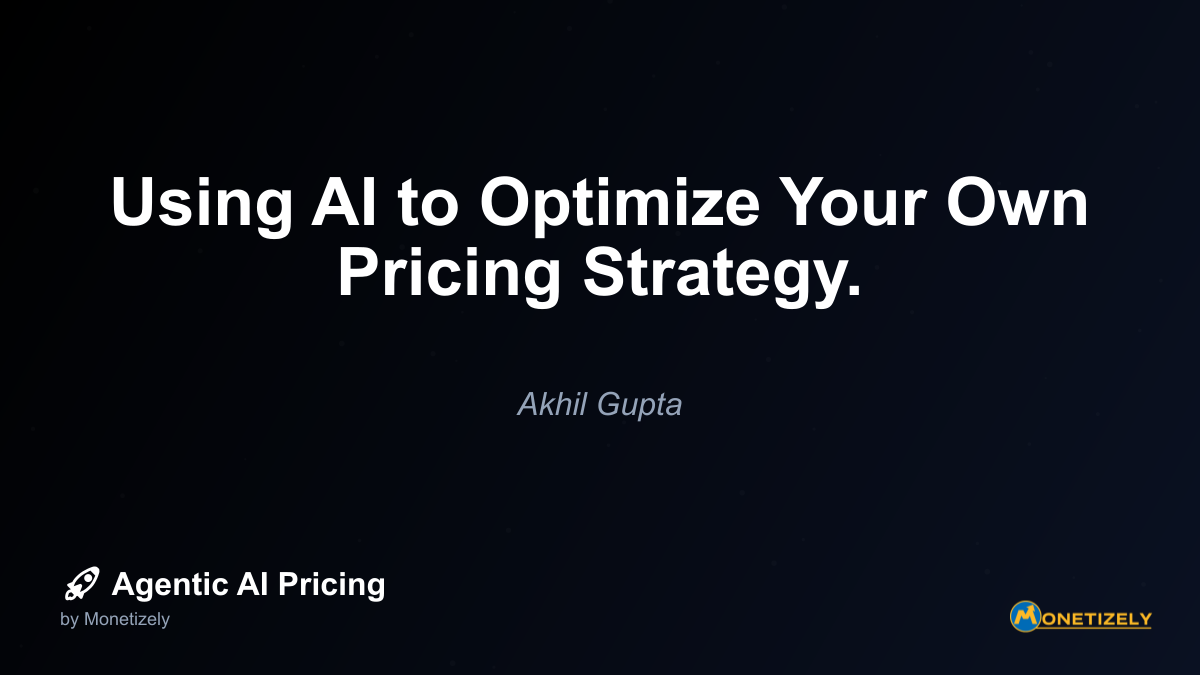
Product Bundle Optimization
AI excels at identifying optimal product bundles and package configurations by analyzing purchase patterns and complementary product relationships. These systems can recommend bundle compositions and pricing that maximize both customer value perception and company profitability.
Competitive Price Positioning
AI-powered competitive intelligence tools continuously monitor competitor pricing across channels, automatically alerting pricing teams to significant competitive movements and recommending appropriate responses based on strategic objectives.
Discount and Promotion Optimization
Rather than applying blanket discounting strategies, AI can identify precisely which promotions will drive desired behaviors for specific customer segments without unnecessarily sacrificing margin. These systems optimize discount timing, depth, and targeting to maximize promotional ROI.
For a deeper exploration of personalized pricing strategies using AI, you might find our detailed guide on using AI to tailor prices for each customer particularly valuable.
Implementation Roadmap: From Data to Decisions
Successfully implementing AI-powered pricing requires a structured approach that builds on existing pricing capabilities while introducing new technologies and processes:
1. Data Foundation Assessment
The journey begins with an honest evaluation of your organization’s data foundation:
- Data inventory: What pricing, customer, transaction, and market data do you currently collect?
- Data quality: How accurate, complete, and timely is your pricing-related data?
- Data integration: Are your data sources connected in ways that enable comprehensive analysis?
- Data governance: Do you have appropriate policies for managing sensitive pricing data?
Organizations often discover significant gaps in their data foundation during this assessment. Common issues include siloed data across departments, inconsistent data definitions, and missing historical information that would power predictive models.
2. Strategic Objective Alignment
Before implementing AI pricing tools, clearly define what you hope to achieve:
- Revenue growth
- Margin improvement
- Market share expansion
- Customer retention
- New customer acquisition
- Inventory optimization
Different objectives may require different AI approaches and metrics for success. For example, a strategy focused on customer retention might emphasize personalized pricing and loyalty-based discounting, while a margin improvement initiative might focus on identifying underpriced products and services.
3. Technology Selection and Integration
Based on your data foundation and strategic objectives, select appropriate AI pricing technologies:
- Build vs. buy decision: Develop custom AI pricing capabilities or implement commercial solutions
- Integration requirements: How will AI pricing systems connect with existing ERP, CRM, and e-commerce platforms?
- Deployment approach: Cloud-based, on-premises, or hybrid implementation
- User interface needs: How will pricing managers interact with AI recommendations?
For organizations new to AI pricing, starting with focused commercial solutions often provides faster time-to-value than building custom systems from scratch.
4. Pilot Program Design
Before full-scale implementation, design limited pilot programs to validate AI pricing approaches:
- Select specific product categories or customer segments for initial testing
- Establish clear success metrics and measurement methodologies
- Create side-by-side comparison opportunities between AI and traditional pricing
- Define escalation procedures for handling unexpected pricing recommendations
Pilot programs build organizational confidence in AI pricing while identifying implementation challenges before broader rollout.
5. Change Management and Capability Building
AI pricing requires new skills and mindsets throughout the organization:
- Training programs: Equip pricing teams to interpret and act on AI recommendations
- Process redesign: Adjust pricing workflows to incorporate AI insights
- Performance metrics: Update how pricing performance is measured and rewarded
- Communication strategy: Help stakeholders understand the role of AI in pricing decisions
The human dimension of AI pricing implementation often determines success or failure. Organizations that invest in change management see faster adoption and better results.
6. Continuous Improvement Framework
AI pricing is not a one-time implementation but an ongoing capability:
- Establish regular review cycles for model performance
- Create feedback loops between market results and model refinement
- Develop processes for handling model drift as market conditions change
- Continually expand data sources to enhance model accuracy
The most successful organizations treat AI pricing as a living system that continuously evolves with the business and market.
Overcoming Common Implementation Challenges
Organizations implementing AI pricing typically encounter several common challenges:
Data Quality and Integration Issues
AI pricing models are only as good as the data that powers them. Many organizations discover data quality problems only after beginning implementation. Addressing these issues requires:
- Data cleansing and standardization procedures
- Master data management strategies for pricing information
- Data integration architecture that connects relevant systems
- Data governance policies that ensure ongoing quality
Organizations that proactively address data quality issues before full implementation avoid costly rework and disappointing initial results.
Algorithm Transparency and Trust
Pricing managers may resist “black box” recommendations they don’t understand. Building trust in AI pricing requires:
- Explainable AI approaches that clarify the rationale behind recommendations
- Visualization tools that illustrate relationships between variables
- Confidence metrics that indicate prediction reliability
- Override capabilities that maintain human judgment in the process
The goal is not to replace human pricing expertise but to augment it with AI capabilities that handle computational complexity while preserving strategic control.
Organizational Resistance
Pricing is often deeply embedded in organizational culture, making change particularly challenging. Successful implementations address resistance through:
- Executive sponsorship that signals strategic importance
- Early involvement of pricing teams in system design
- Celebration of early wins that demonstrate value
- Transparent communication about how AI will affect roles
Organizations that treat AI pricing as a collaborative human-machine partnership rather than a replacement for human judgment see higher adoption rates and better outcomes.
Measuring Success: Key Performance Indicators
Effective AI pricing implementation requires clear metrics to evaluate performance:
Financial Impact Metrics
- Revenue lift: Percentage increase in overall revenue
- Margin improvement: Changes in gross and net margin percentages
- Price realization: Actual vs. list price achievement
- Discount effectiveness: Revenue generated per discount dollar
Operational Efficiency Metrics
- Pricing decision velocity: Time required to analyze and implement price changes
- Pricing consistency: Variation in similar customer/product scenarios
- Scenario modeling capacity: Number of pricing scenarios evaluated before decisions
- Exception handling: Percentage of pricing decisions requiring manual intervention
Strategic Alignment Metrics
- Customer retention impact: Changes in renewal rates or customer churn
- Share of wallet: Changes in customer spending concentration
- Competitive win rate: Success in competitive bidding situations
- New product adoption: Impact on new offering uptake
Comprehensive measurement frameworks combine these metrics to provide a holistic view of AI pricing performance across financial, operational, and strategic dimensions.
The Future of AI in Pricing Strategy
As AI pricing technologies continue to evolve, several emerging trends will shape future capabilities:
Autonomous Pricing Systems
The next generation of AI pricing will move beyond recommendations to autonomous implementation within defined parameters. These systems will continuously optimize pricing without human intervention for routine scenarios, while escalating unusual situations for human review.
Ecosystem-Based Pricing Intelligence
Future AI pricing systems will incorporate broader ecosystem data, including:
- Supply chain visibility across multiple tiers
- Environmental and sustainability factors
- Regulatory and compliance considerations
- Social sentiment and brand perception
This expanded view will enable pricing that optimizes for multiple objectives beyond immediate financial performance.
Collaborative AI Pricing Networks
Organizations will increasingly participate in privacy-preserving collaborative networks that enhance pricing intelligence while protecting competitive information. These networks will provide broader market visibility without compromising proprietary data.
Ethical AI Pricing Frameworks
As AI pricing becomes more sophisticated, organizations will develop ethical frameworks that address questions of fairness, transparency, and social impact. These frameworks will ensure that AI pricing aligns with organizational values and societal expectations.
Conclusion: The Strategic Imperative of AI-Powered Pricing
Implementing AI for pricing optimization is no longer a futuristic concept—it’s a present-day competitive necessity. Organizations that successfully deploy these technologies gain significant advantages in market responsiveness, customer satisfaction, and financial performance.
The journey from traditional pricing approaches to AI-powered optimization requires thoughtful planning, cross-functional collaboration, and continuous refinement. However, the potential rewards—revenue growth, margin improvement, and strategic differentiation—make this transformation essential for forward-thinking organizations.
As you consider your organization’s approach to AI pricing, focus on these key principles:
- Start with clear strategic objectives rather than technology for its own sake
- Build a solid data foundation before implementing advanced algorithms
- Balance algorithmic sophistication with practical business application
- Invest in the human capabilities needed to leverage AI effectively
- Establish measurement frameworks that demonstrate concrete business impact
By embracing AI-powered pricing optimization as a core strategic capability, organizations position themselves to thrive in increasingly complex and competitive markets. The future belongs to those who can harness the computational power of AI while preserving the strategic judgment that defines truly exceptional pricing.
Co-Founder & COO
Akhil is an Engineering leader with over 16+ years of experience in building, managing and scaling web-scale, high throughput enterprise applications and teams. He has worked with and led technology teams at FabAlley, BuildSupply and Healthians. He is a graduate from Delhi College of Engineering and UC Berkeley certified CTO.
Pricing Strategy Audit
Let our experts analyze your current pricing strategy and identify opportunities for improvement. Our data-driven assessment will help you unlock untapped revenue potential and optimize your AI pricing approach.

